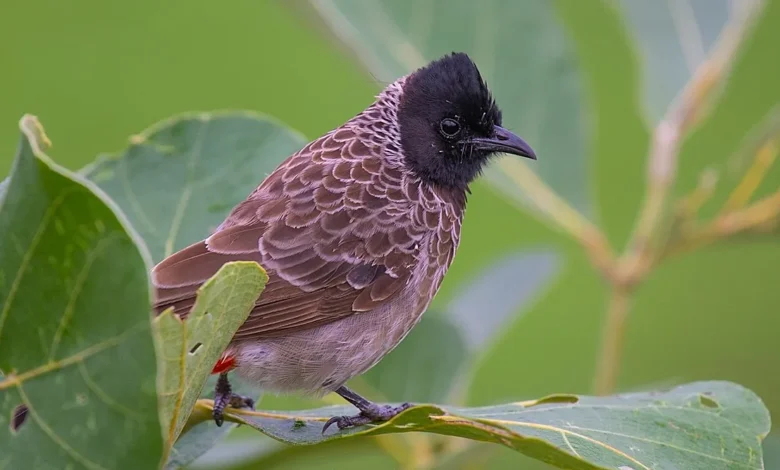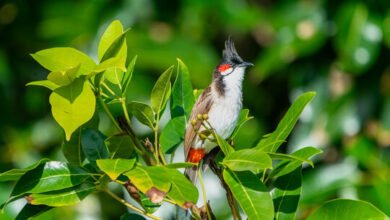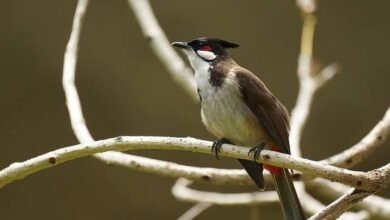The Red Whiskered Bulbul: A Stunning and Melodic Bird of India

The Red Whiskered Bulbul (Pycnonotus jocosus) is a captivating bird with its striking appearance and pleasant song. Commonly found in South Asia, it has become one of the most recognized and loved species due to its vibrant plumage and charming presence in gardens and forests. This article takes a deep dive into the characteristics, behavior, habitat, and ecological importance of the Red Whiskered Bulbul.
Overview of the Red Whiskered Bulbul
The Red Whiskered Bulbul is a medium-sized songbird with distinct red markings and a crest on its head. Known for its high-pitched calls and energetic behavior, this bird is a popular sight in both urban and rural landscapes across India, Sri Lanka, and parts of Southeast Asia. It is a member of the Pycnonotidae family, which includes a wide variety of bulbul species, but the Red Whiskered Bulbul stands out because of its aesthetic appeal and active lifestyle.
Physical Characteristics
One of the most striking features of the Red Whiskered Bulbul is its vibrant color palette. The bird has a black crest on its head, white cheeks, and a prominent red patch beneath its eyes, which is how it gets its name. The bird’s body is mostly brown, and it has a red vent at the base of its tail, further enhancing its bright appearance.
| Physical Feature | Description |
|---|---|
| Crest | Black, prominent on top of the head |
| Face | White cheeks with red “whiskers” below the eyes |
| Body | Brown with a lighter underside |
| Tail | Dark with a red vent (underside of the tail) |
| Size | 20 to 23 cm in length |
Distinguishing Characteristics
The male Red Whiskered Bulbul is generally more vivid than the female. However, both sexes share the same color pattern, though the male tends to have a slightly larger crest. The bird is often confused with the Red-vented Bulbul, another member of the same family, but the Red Whiskered Bulbul’s “whiskers” are a distinguishing feature that sets it apart.
See also: Red-Whiskered Bulbul: A Beautiful Songbird of South Asia
Habitat and Distribution
Red Whiskered Bulbuls thrive in a variety of habitats, from open forests and gardens to urban parks and plantations. They are predominantly found in tropical and subtropical regions of South Asia, including:
- India
- Sri Lanka
- Bangladesh
- Nepal
- Parts of Myanmar and Thailand
These birds prefer areas with dense vegetation, as they build their nests in shrubs or low trees. Their adaptability to both rural and urban environments makes them a common sight in gardens and backyards, where they often forage for food.
Diet and Feeding Behavior
The Red Whiskered Bulbul is an omnivorous bird, feeding primarily on fruits, nectar, and insects. Its diet consists of:
- Fruits: Berries, guavas, figs, and other soft fruits.
- Nectar: They are known to feed from flowers, especially those that produce abundant nectar.
- Insects: They also consume small insects and larvae, which help provide protein.
Their feeding behavior is quite dynamic, and they are often seen hopping between branches or moving along the ground to forage. They also have a tendency to visit flower gardens, where they can access nectar, a significant part of their diet.
Behavior and Social Structure
Red Whiskered Bulbuls are social and active birds, often seen in pairs or small groups. They are known for their playful nature and are relatively easy to spot in the wild due to their loud, melodious calls. These birds are diurnal (active during the day) and have a relatively high-pitched, repetitive song, which can be heard in the early morning hours.
They are territorial during the breeding season, and males are known to sing loudly to assert their dominance and attract mates. The song of the Red Whiskered Bulbul is one of its most endearing qualities, and many bird enthusiasts enjoy hearing it in their gardens or nearby forests.
Breeding and Nesting
The breeding season for the Red Whiskered Bulbul typically occurs during the warmer months of the year. The female builds a small, cup-shaped nest made from twigs, leaves, and grasses, often placed in dense shrubs or trees, providing protection for the eggs. Both the male and female take turns incubating the eggs, which hatch after about 12–14 days.
Once the chicks are born, both parents are involved in feeding and protecting the young birds. The chicks are initially fed a diet of insects and small fruits and remain in the nest until they are strong enough to fly on their own.
Conservation Status
As of now, the Red Whiskered Bulbul is classified as a species of Least Concern by the International Union for Conservation of Nature (IUCN). The population is stable in most areas, though habitat loss due to urbanization and deforestation can sometimes impact local populations. However, the bird’s adaptability to urban environments, where it finds shelter in gardens and parks, has helped maintain its population in many regions.
Threats
Some of the threats that the Red Whiskered Bulbul faces include:
- Habitat Destruction: Expansion of cities and deforestation can lead to a loss of suitable nesting sites.
- Illegal Pet Trade: Due to their attractive appearance and melodious calls, some Red Whiskered Bulbuls are captured and sold in the illegal pet market.
Despite these threats, the species remains widespread and is not currently at significant risk.
Red Whiskered Bulbul in Culture and Mythology
In South Asia, the Red Whiskered Bulbul is often admired for its beauty and melodic song. In some cultures, it is seen as a symbol of joy and is often associated with nature’s vibrancy. The bird’s cheerful song is believed to bring good luck, and it is a popular subject in art, especially in traditional Indian paintings and poetry.
Additionally, the Red Whiskered Bulbul is a common feature in birdwatching communities and is admired for its resilience and adaptability to diverse environments.
Final Thoughts: A Beautiful and Resilient Bird
The Red Whiskered Bulbul is a fascinating species that offers insight into the complex relationships between animals, their environments, and the broader ecosystem. From its vibrant colors and sweet song to its role in spreading the message of biodiversity, this bird plays an important part in the natural world.
Whether in the wild or in urban gardens, its presence adds a touch of elegance and liveliness. As we continue to face environmental challenges, the Red Whiskered Bulbul’s ability to adapt to various habitats is a testament to the resilience of nature and the importance of preserving our natural spaces for future generations.




